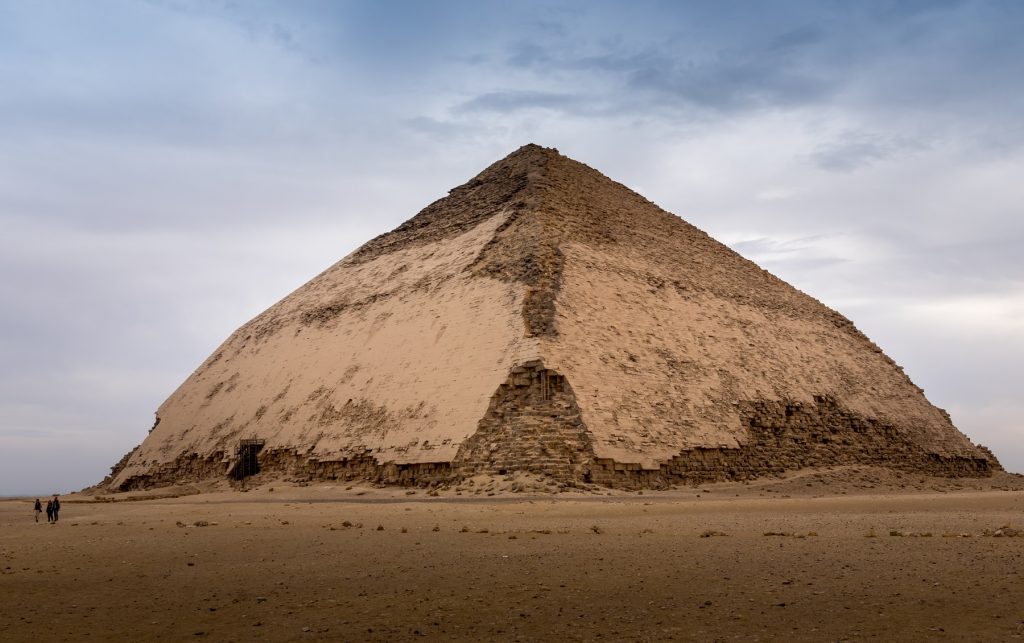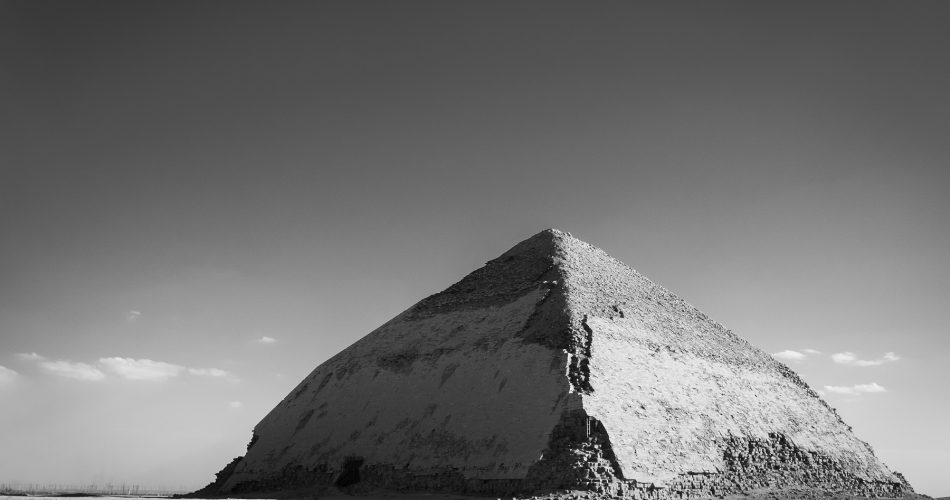Located in the Dahshur necropolis stands a pyramid unlike any other. It was built in such a particular way that it seems to be Bent. Located around 40 kilometers from Cairo, the ancient Pyramid is thought to have been King Sneferu’s second pyramid, erected according to Egyptologists around 4,600 years ago. The pyramid is unique for a number of reasons, but mostly because of its curiously bent shape. It is also one of the few pyramids that retain nearly all of its casing stones.
The structure rises from Dahshur’s golden desert plateau at a 54-degree inclination but its uppermost section, from 47 meters upwards, was built with a much shallower angle of 43 degrees. This is what gives the pyramids its unique, bent appearance.
As explained by Mark Lehner in his book “The Complete Pyramids,” when the pyramid was in its initial construction phase, it had faces that sloped about 72 to 78 degrees. This was too steep for a true pyramid. Evidence within the very core of the pyramid suggests that the pyramid started off as a much smaller structure, with a slope of around 60 degrees. Structure problems eventually began showing up, and the builders were forced to make changes to the structure by adding material around the stump of the pyramid, which turned into a structure with a slope of 55 degrees.
However, even this wasn’t enough for the pyramid to remain stable. The early stages of the pyramid are thought to have been built using a traditional method by which the builders laid down courses with the stones sloping inward. But the reduced angle didn’t help, and the builders would need to make further improvements. That’s why, about halfway through the construction, the courses were laid horizontally as it became clear that inward leading courses did not add stability to the pyramid, but instead added more stress to the structure.
the pyramid was eventually built at a much decreased angle giving it its pronounced bent.
The pyramids’ ancient name is thought to have been Southern-Shining-Pyramid, or Sneferu-(is)-Shining-in-the-South. The pyramid was first excavated in 1956 by archaeologists who found the pyramid void of the pharaoh’s mummy and any other items. The pyramid had remained inaccessible to the general public for decades. This changed in July 2019 when Egypt’s ministry of Antiquities decided to reopen the Bent Pyramid for tourists for the first time since 1965.
Tourists can now access its interior through a narrow tunnel that was built leading from the structure’s northern entrance.
The exact reason for this is somewhat debated, but most Egyptologists will agree that it is because the Bent Pyramid was still not a perfect pyramid, and it represents a transitional phase between a step-sided and smooth-sided pyramid. In other words, the Bent Pyramid of Sneferu was most likely an experimental pyramid and the construction project behind the monument saw builders experiment with various techniques and designs. Furthermore, it is believed that the builders were forced to change the angle of inclination of 54 degrees during construction as the pyramid became unstable.
This is mostly archaeological guesswork. Nonetheless, this theory seems to be supported by Sneferu’s Red Pyramid, located next to the Bent Pyramid. The builders of the Red Pyramid immediately adopted a 43-degree inclination during the construction of Sneferu’s third pyramid.

Some researchers believe that this was a precaution in reaction to the collapse of Sneferu’s first pyramid, the pyramid at Meidum, which the builders tried reshaping from a step pyramid to a smooth-sided one.
As mentioned earlier, the Bent Pyramid is unique among more than 120 pyramids that have been documented in Egypt, and that’s because its limestone casing stones remain largely intact. As explained by British structural engineer Peter James, this may have been thanks to larger clearances between “the parts of the casing than used in later pyramids.”
These imperfections may have helped the structure as they probably worked as expansion joints, which helped reduce the successive destruction of the casing of the pyramid caused by thermal expansion. Other pyramids built after the Bent Pyramid were much more precise, and this may have been one of the reasons why their casing is now gone.
The Bent Pyramid was built having two entrances. One of these is located on the lower parts on the pyramid’s northern side. This entrance now features a wooden stairway built for tourists. Its second entrance was built onto the western face of the pyramid. Each of the entrances leads towards a chamber with corbelled roofs. The northern entrances lead towards a chamber that was built beneath the pyramid, below ground level, while the second chamber was constructed into the body of the pyramid itself.
The Bent Pyramid has a base measuring 189.43 meters (621 ft; 362 cu) by 123.58 meters (405 ft; 236 cu). It was built with an estimated volume of 1,237,040 cubic meters (43,685,655 cu ft), which means it nearly has four times the volume of Egypt’s first pyramid, the Step Pyramid of Djoser at Saqqara.
Sneferu’s Bent Pyramid is of great importance in our understanding of ancient Egyptian pyramids, as it may bear “records in stone” of the evolution of pyramid-building techniques of ancient Egypt. Egyptologists believe that the construction of the Bent pyramid, as well as the mistakes its builders made, played a crucial role in the construction of Sneferu’s next pyramid, the Red Pyramid. This pyramid, in turn, is thought to have laid down the foundations for the successful construction of Egypt’s most marvelous pyramid, the Great Pyramid of Giza.

